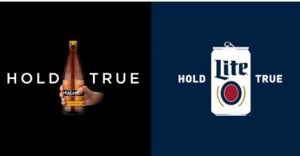By D. John Hendrickson

In the end of March 2017, advertiser Magners Irish Cider accused Miller Lite and its advertising agency of using Magner’s HOLD TRUE tagline in a Miller Lite campaign. Magners went public and Tweeted “@MillerLite Imitation is the sincerest form of flattery they say…#HoldTrue.” While Magners was clearly having fun at Miller Lite’s expense, things could have taken a serious turn if Magners had accused Miller of trademark infringement.
The Magners/Miller bar fight is a good reminder that for headlines and taglines, a preliminary trademark search should be performed to determine a risk level prior to use in a campaign. The idea is to assess the risk of potential trademark infringement before the campaign goes public. This is especially true for taglines that may have a long and prominent shelf life. While a prelim search may not prevent an infringement issue from coming out of the proverbial woodwork, it’s a best practice to try and avoid an issue in the first place when concerning results are discovered.
So what exactly is a Preliminary Search?
The first step in a preliminary search is to check the U.S. Patent and Trademark Office database for exact or similar matches to a proposed headline or tagline. This analysis can be fairly straight forward, or it can be exceedingly detailed depending on the search results. This includes whether the results are found in identical or related goods & services. The training and experience of qualified legal counsel comes into play here as USPTO searches can have unexpected results and proper legal analysis is important. Trademark infringement is based on whether there is confusion in the marketplace for the source of the goods, and many times, a nuanced analysis is needed.
The second step is to conduct an online search to see if similar use exists out in the world. Remember, a trademark does not have to be registered with the USPTO in order for an entity to claim IP rights to the mark. These are called common law trademarks when they are used to identify a product or service in commerce but are not registered with the USPTO.
After both the USPTO and online searches are complete, a risk analysis should be prepared so that both the agency and the advertiser are aware of potential risks for use in a campaign. For taglines or long running headlines, it may also be prudent to conduct an additional search via a Thomson Search. This is a deeper dive and analysis conducted by Thomson Reuters to confirm the preliminary results, and to potentially identify other problematic marks used in commerce.
What’s the worse that can happen? Maybe they send a Cease & Desist letter?
Like Magners, it’s possible that an advertiser may take a non-threatening view of the alleged infringement. On the other hand, if the advertiser has vested intellectual property rights in a registered or common law trademark or service mark, then it may feel compelled to defend those rights or potentially lose its rights to the mark. If the advertiser feels strongly that its rights were infringed upon (especially by a competitor), then it may demand a withdrawal of the campaign from all media. Even worse, it could file trademark infringement litigation and seek damages from the alleged infringer. This would be a really bad day for all concerned. Again, a preliminary search may not catch every potential issue, but it’s a highly recommended first step. Our motto is: Don’t launch a campaign without it.
Disclaimer: This post does not constitute medical advice regarding headache prevention. See your qualified healthcare professional.
Legal disclaimer: This article is not intended to constitute legal advice or to create an attorney-client relationship. We trust you knew this anyway.